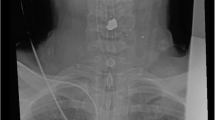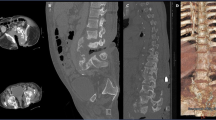Abstract
Introduction
Retained shrapnel from gunshots is a common occurrence; however, retained shrapnel within the spinal canal is exceedingly uncommon. Guidelines for removal and treatment of these cases are a difficult topic, as surgical removal is not necessarily without consequence, and retention can lead to possible further injury or a secondary disease process of plumbism, which can be difficult to diagnose in this population.
Case presentation
This case report provides a unique example of a young patient with retained shrapnel from a gunshot. This patient suffered an initial spinal cord injury due to a gunshot and secondarily presented with abdominal pain, fatigue, elevated blood lead levels, and was diagnosed with plumbism. This was addressed with operative removal of shrapnel and posterior instrumented spinal fusion, resulting in decreased lead levels and symptom resolution postoperatively.
Discussion
Lead toxicity risk in patients with retained shrapnel, particularly in the spine, warrants vigilant monitoring. While management guidelines lack consensus, symptomatic lead toxicity may necessitate intervention. Residual neurological deficits complicate evaluation, emphasizing individualized management decisions.
This is a preview of subscription content, access via your institution
Access options
Subscribe to this journal
Receive 1 print issues and online access
We are sorry, but there is no personal subscription option available for your country.
Buy this article
- Purchase on Springer Link
- Instant access to full article PDF
Prices may be subject to local taxes which are calculated during checkout




Similar content being viewed by others
Data availability
The data generated or analyzed during this study was made up of several single data points recording this patient’s lead levels over time can be found within the published article and its supplementary files.
Change history
29 April 2024
The last word of the article title has been corrected.
References
Zwald ML, Holland KM, Bowen DA, Simon TR, Dahlberg LL, Stein Z, et al. Using the centers for disease control and prevention’s national syndromic surveillance program data to monitor trends in us emergency department visits for firearm injuries, 2018 to 2019. Ann Emerg Med. 2022;79:465–73. https://doi.org/10.1016/j.annemergmed.2022.01.016.
Kaufman EJ, Wiebe DJ, Xiong RA, Morrison CN, Seamon MJ, Delgado MK. Epidemiologic trends in fatal and nonfatal firearm injuries in the US, 2009-2017. JAMA Intern Med. 2021;181:237–44. https://doi.org/10.1001/jamainternmed.2020.6696.
Nickel WN, Steelman TJ, Sabath ZR, Potter BK. Extra-articular retained missiles; is surveillance of lead levels needed? Mil Med. 2018;183:e107–e113. https://doi.org/10.1093/milmed/usx076.
Nguyen MP, Reich MS, OʼDonnell JA. Infection and complications after low-velocity intra-articular gunshot injuries. J Orthop Trauma. 2017;31:330–3. https://doi.org/10.1097/bot.0000000000000823.
Rentfrow RV, Elia C, Sethi A. Lead toxicity and management of gunshot wounds in the lumbar spine. Eur Spine J. 2013;22:2353–7. https://doi.org/10.1007/s00586-013-2805-6.
Towner JE, Pieters TA, Maurer PK. Lead toxicity from intradiscal retained bullet fragment: management considerations and recommendations. World Neurosurg. 2020;141:377–82. https://doi.org/10.1016/j.wneu.2020.05.112.
Shefa ST, Héroux P. Both physiology and epidemiology support zero tolerable blood lead levels. Toxicol Lett. 2017;280:232–7. https://doi.org/10.1016/j.toxlet.2017.08.015.
de Araújo GC, Mourão NT, Pinheiro IN, Xavier AR, Gameiro VS. Lead toxicity risks in gunshot victims. PLoS ONE. 2015;10:e0140220. https://doi.org/10.1371/journal.pone.0140220.
Mitra P, Sharma S, Purohit P, Sharma P. Clinical and molecular aspects of lead toxicity: an update. Crit Rev Clin Lab Sci. 2017;54:506–28. https://doi.org/10.1080/10408363.2017.1408562.
Dienstknecht T, Horst K, Sellei RM, Berner A, Nerlich M, HardCastle TC. Indications for bullet removal: overview of the literature, and clinical practice guidelines for European trauma surgeons. Eur J Trauma Emerg Surg. 2012;38:89–93. https://doi.org/10.1007/s00068-011-0170-x.
Author information
Authors and Affiliations
Contributions
Ezekial J Koslosky MD—Conceptualization, Investigation, Writing—Original Draft, Writing Review and Editing, Project Administration. Samuel Oshoba BA—Writing—Original Draft, Writing Review and Editing. Connor Armstrong MD—Investigation, Writing Review, and Editing. Christopher Chaput MD—Conceptualization, Supervision. Matthew Landrum MD—Conceptualization, Writing Review and Editing, Supervision.
Corresponding author
Ethics declarations
Competing interests
The authors declare no competing interests.
Ethics approval
Ethical approval was not required for this case report as it involved the retrospective analysis of de-identified patient data and did not involve any interventions or procedures beyond routine clinical care. Furthermore, the study did not involve any identifiable information, and strict adherence to patient confidentiality was maintained throughout the data collection and reporting process. Thus, no formal ethical approval was sought or obtained for this case report.
Additional information
Publisher’s note Springer Nature remains neutral with regard to jurisdictional claims in published maps and institutional affiliations.
Rights and permissions
Springer Nature or its licensor (e.g. a society or other partner) holds exclusive rights to this article under a publishing agreement with the author(s) or other rightsholder(s); author self-archiving of the accepted manuscript version of this article is solely governed by the terms of such publishing agreement and applicable law.
About this article
Cite this article
Koslosky, E., Oshoba, S., Armstrong, C. et al. Navigating the complexity of spinal cord injuries with retained foreign bodies and the diagnostic challenge of lead toxicity—a case report. Spinal Cord Ser Cases 10, 28 (2024). https://doi.org/10.1038/s41394-024-00640-7
Received:
Revised:
Accepted:
Published:
DOI: https://doi.org/10.1038/s41394-024-00640-7



